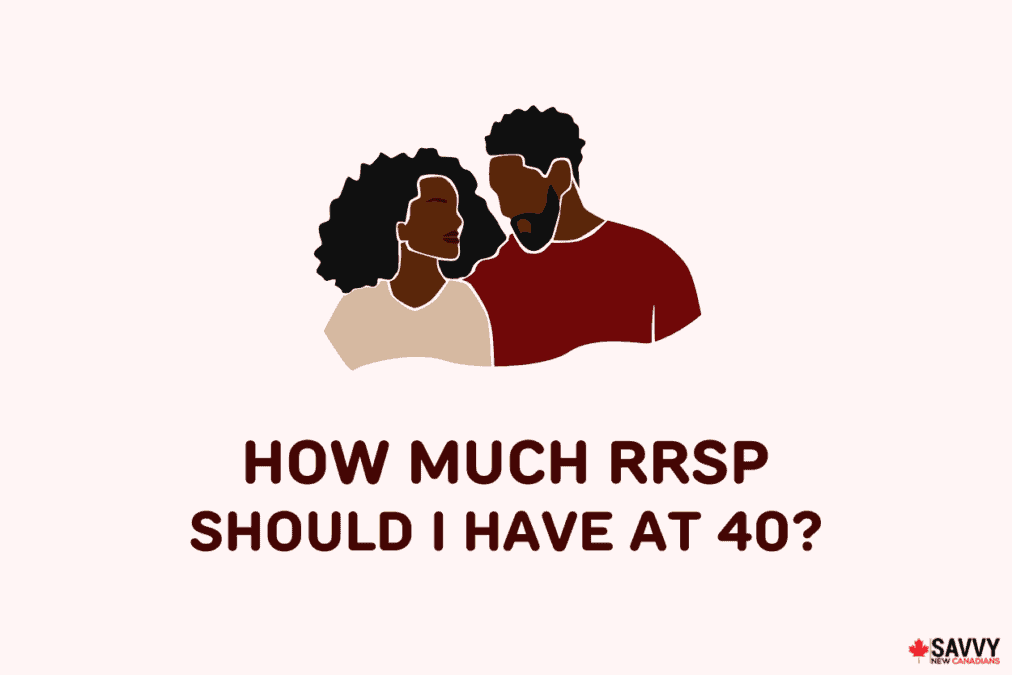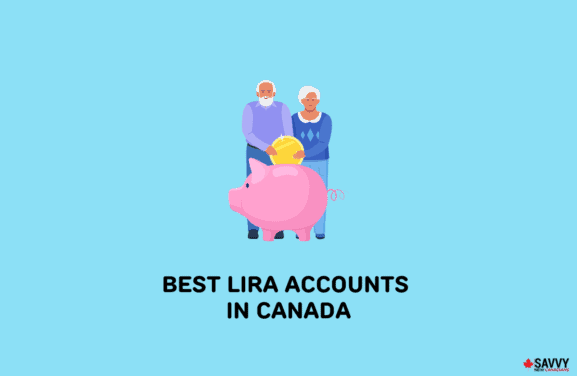How much money will you need to retire comfortably in Canada?
This all-important question often leads Canadians to ask other pertinent questions, such as ‘how much RRSP should I have at age 40, 50, or 60?’
Since RRSPs are one of the main pillars of retirement income alongside government-sponsored pension plans and workplace pensions, investing in your RRSP can significantly impact your ability to retire on your own terms.
This guide will cover how much RRSP you should have by age 40, how to calculate retirement income needs and more.
RRSP Savings By Age in Canada
While I am focusing on RRSP savings in this section, retirement savings usually consist of a combination of RRSPs, Tax-Free Savings Accounts (TFSAs), government-administered pension plans (OAS and CPP), and workplace retirement plans.
When all these are factored into your retirement savings, you will likely need a lot less than imagined in your RRSP.
Fidelity suggests you should plan to have the following multiples of your salary at various age thresholds:
Table 1:
| Your Age | Retirement Savings |
| 30 years | 1 x income |
| 35 years | 2 x income |
| 40 years | 3 x income |
| 45 years | 4 x income |
| 50 years | 6 x income |
| 55 years | 7 x income |
| 60 years | 8 x income |
| 67 years | 10 x income |
Age 67 on this table reflects U.S. retirement planning since this is the age when full Social Security benefits kick in. For Canadians, full Old Age Security (OAS) is available at the age of 65.
I think the Fidelity benchmarks can be a bit challenging to meet, especially when you are in the 30 to 40 years age group.
We can tweak our calculations a bit by using modified benchmarks provided by T. Rowe Price and will use these for estimating how much RRSP savings you should have at age 40.
Table 2:
| Investor’s Age | Savings Benchmark | Midpoint |
| 30 years | Half of Salary | 1/2x |
| 35 years | 1x to 1.5x salary | 1x |
| 40 years | 1.5x to 2.5x salary | 2x |
| 45 years | 2.5x to 4x salary | 3x |
| 50 years | 3x to 5.5x salary | 5x |
| 55 years | 4.5x to 8x salary | 7x |
| 60 years | 6x to 11x salary | 9x |
| 65 years | 7x to 13.5x salary | 11x |
How Much RRSP Should You Have at Age 40?
You should have two times your annual income in retirement savings by age 40.
While it is challenging to provide the exact RRSP numbers you need at a certain age, we will use the multiples above to provide estimations.
As per Statistics Canada, the income data for 2020 showed that:
- Average annual income for age group 35 to 44 years: $65,800
- Median annual income for age group 35 to 44 years: $54,800
Going with the average income in Canada in the 35 to 44 years range and a 2 x benchmark savings multiple (midpoint multiple at 40 years in Table 2), you should aim to have around $131,600 by age 40 (i.e. 2 x $65,800).
Going by the median income amount, which excludes extremely high salaries for this age group, you should have around $109,600 in your RRSP by age 40.
| Income Statistics | RRSP Target at Age 40 |
| Median income (35 to 44 years) | $109,600 |
| Average income (35 to 44 years) | $131,600 |
These estimates are only designed to help you put numbers on what could otherwise be a nebulous goal. Your mileage will vary.
For example, you could earn significantly more or less than the average and median annual wages for your age group.
Also, we are assuming you don’t have savings in a Tax-Free Savings Account (TFSA) or workplace pension.
If you do, your retirement savings can be split across these accounts.

What If You Are Falling Behind At Age 40?
What if your RRSP or retirement savings are falling behind at age 40?
Well, it is not too late. Look beyond your RRSP numbers. How much do you have in your TFSA? How much is your employment pension worth? How much do you expect to receive in government pensions – OAS, GIS, and CPP?
With a 20+ year investment timeframe, you should take reasonable risks in your investment portfolio.
If you are just beginning to invest, you may need to double up your savings rate – think 15%, 20%, or even higher.
How Much RRSP Do I Need To Retire?
These factors will impact your retirement income needs:
- Age at which you retire
- Health status and life expectancy
- Government benefits and pension amounts
- Workplace pensions (defined benefit pension plans, defined contribution pension plans, or group RRSPs)
- Lifestyle in retirement
- Inflation
- Taxes (duh!)
We can account for CPP and OAS benefits by using the average CPP amount and full OAS amount as of 2024.
For a couple, the combined annual average CPP and full OAS are $35,319.84 per year.
| Annual OAS | Annual CPP | Total | |
| Spouse 1 | $8,560.08 | $9,099.84 | $17,659.92 |
| Spouse 2 | $8,560.08 | $9,099.84 | $17,659.92 |
| Total | – | – | $35,319.84 |
For a single individual, the combined annual average CPP and full OAS pension amount are $17,659.92 per year.
Assuming you do not have a TFSA or workplace pension, we can estimate your RRSP needs as follows:
Example of RRSP Needs for a Couple
A couple determines they need $65,000 annually to live comfortably in retirement.
With $35,319.84 already provided by government pensions (using 2024 numbers), they have a shortfall of $29,680.16 (i.e. $65,000 – $35,319.84) that has to be covered by their RRSP.
They will need an additional $742,004 in their combined RRSP accounts at age 65, using a 4% safe withdrawal rate.
This amount can also be split across their TFSA, workplace pensions, or non-registered savings.
Example of RRSP Needs for a Single Individual
A single individual determines they need $40,000 per year to be able to retire comfortably.
With $17,659.92 already accounted for via the CPP and OAS (using 2024 numbers), they have a shortfall of $22,340.08 (i.e. $40,000 – $17,659.92) that has to be covered by their RRSP.
As such, they will need an additional $558,502 in their retirement account, using a 4% safe withdrawal rate.
To summarize:
| Single | Couple | |
| Retirement income need | $40,000 | $65,000 |
| Minus government pensions (OAS & CPP) | $17,659.92 | $35,319.84 |
| Minus TFSA | $0 | $0 |
| Minus workplace pension | $0 | $0 |
| Shortfall in retirement savings | $22,340.08 | $29,680.16 |
| Safe withdrawal rate | 4% | 4% |
| RRSP savings required | $558,502 | $742,004 |
Assumptions:
- TFSA, workplace pensions, and non-registered investment savings are assumed to be $0
- “RRSP savings required” is calculated as the shortfall divided by 4% (or 25x)
- The 4% “safe withdrawal rate” has many other assumptions, such as a balanced portfolio, a 30-year drawdown period, etc.
What is an RRSP?
A Registered Retirement Savings Plan (RRSP) is a government-registered account you can use to save toward retirement.
Your contributions to this plan are tax-deductible, and you don’t pay taxes on investment income until you begin making withdrawals.
The RRSP contribution limit in 2024 is 18% of your earned income in 2023, up to a maximum of $31,560.
RRSP Investments
You can hold a variety of investments in your RRSPs:
- Savings (cash)
- Exchange-Traded Funds (ETFs)
- Individual stocks
- Bonds
- Mutual funds
- Precious metals
- Real Estate Investment Trusts (REITs)
- Guaranteed Investment Certificates (GICs)
You can use an RRSP Calculator to calculate how much your RRSP will be worth in the future based on your savings rate, the annual rate of return, and the number of years until retirement.
For a professionally managed portfolio and low management fees, a robo-advisor like Wealthsimple can help.
For self-directed investing, you can use these commission-free brokerage platforms.
RRSP Calculator
Related:




would love to see articles like this for 15k and 30k salary people who have no benefits lol min wage workers ya know?
@Min Wage: Good point. The multiples used in this example can be applied to any income level.
I am very disappointed in this article. Following anything close to this advice would usually mean a huge tax bill when you are retiring. And if someone does not melt down most of your RRSP before they start collecting OAS, there would usually be significant clawback on the OAS. With a large RRSP, untimely death could also result in significant estate tax.
Your advice on saving for retirement is correct. Just do not keep it all in their RRSP, especially if they are in the lower tax brackets. There should be more emphasis on using their TFSA.
@Kelvin: This analysis uses the RRSP to simplify retirement income calculation. Many people will also have a TFSA and will split their nest egg across RRSP, TFSA, and non-registered investment accounts. Many will also have workplace pensions.
You make a good point regarding maximizing the TFSA if you are in a lower tax bracket. We have covered this angle in many articles as well.
https://www.savvynewcanadians.com/when-you-should-prioritize-tfsa-over-rrsp/